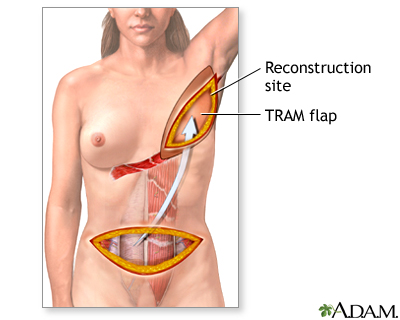Breast reconstruction
Indication, part 1
|
|
The normal female breasts are paired structures that contain fat and glandular tissue designed to secrete milk. Cancer of the breast is one of the more common cancers in women. Risk factors include a family history of breast cancer, early age at first period, and late menopause.
|
Indication, part 2
|
|
Breast removal (mastectomy), is performed most frequently for cancer of the breast. Occasionally, in patients with a strong family history of breast cancer and genetic abnormalities that predispose them to breast cancer, bilateral prophylactic mastectomies are performed to prevent the future occurrence of breast cancer.
|
Incision
|
|
Reconstruction of the breast after mastectomy is performed in select patients who have very small tumors, or who undergo prophylactic (preventative) bilateral mastectomy. First, tissue from the lower abdomen, including skin, muscle, and blood vessels, is removed. This is called a TRAM flap.
|
Procedure, part 1
|
|
The flap is then transferred under the skin between the two sites, and sutured into place.
|
Procedure, part 2
|
|
Alternatively, a saline filled prosthesis can be implanted under the skin and muscle after mastectomy. Over the next few weeks and months, the prosthesis is slowly filled with increasing amounts of saline by injection, which expands the overlying skin and creates a breast mound.
|
Aftercare
|
|
The final step is nipple reconstruction. One method involves taking a partial graft from the remaining nipple to create a new one. In another method, the surgeon raises a small area of skin on the reconstructed breast and tattoos it at a later date. The overall results of breast reconstruction, while not perfect, are usually excellent. Nevertheless, patients should discuss their expectations with their surgeon at length prior to surgery.,
|

Review Date:3/11/2023
Reviewed By:Debra G. Wechter, MD, FACS, General Surgery Practice Specializing in Breast Cancer, Virginia Mason Medical Center, Seattle, WA. Also reviewed by David C. Dugdale, MD, Medical Director, Brenda Conaway, Editorial Director, and the A.D.A.M. Editorial team.
The information provided herein should not be used during any medical emergency
or for the diagnosis or treatment of any medical condition. A licensed medical professional
should be consulted for diagnosis and treatment of any and all medical conditions. Call 911
for all medical emergencies. Links to other sites are provided for information only -- they
do not constitute endorsements of those other sites. © 1997-A.D.A.M., Inc. Any duplication or distribution of the information contained herein is strictly prohibited.
The Agency for Health Care Administration (Agency) and this website do not claim the information on, or referred to by, this site is error free. This site may include links to websites of other government agencies or private groups. Our Agency and this website do not control such sites and are not responsible for their content. Reference to or links to any other group, product, service, or information does not mean our Agency or this website approves of that group, product, service, or information.
Additionally, while health information provided through this website may be a valuable resource for the public, it is not designed to offer medical advice. Talk with your doctor about medical care questions you may have.






